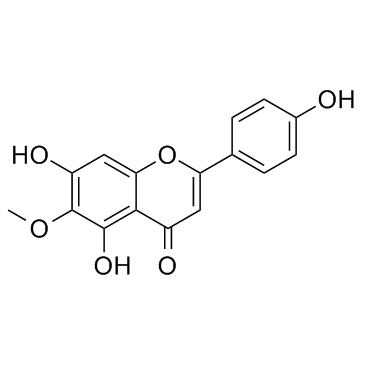Hispidulin

Hispidulin structure
|
Common Name | Hispidulin | ||
|---|---|---|---|---|
| CAS Number | 1447-88-7 | Molecular Weight | 300.263 | |
| Density | 1.5±0.1 g/cm3 | Boiling Point | 601.5±55.0 °C at 760 mmHg | |
| Molecular Formula | C16H12O6 | Melting Point | N/A | |
| MSDS | USA | Flash Point | 230.1±25.0 °C | |
| Symbol |

GHS07 |
Signal Word | Warning | |
|
Analysis of vervain flavonoids by HPLC/Diode array detector method. Its application to quality control.
J. Agric. Food Chem. 47(11) , 4579-82, (1999) A reversed-phase HPLC procedure is proposed for the determination of seven flavonoids (luteolin, nepetin, hispidulin, jaceosidin, cirsimaritin, cirsilineol, and eupatorin) in vervain samples. A simple extractive technique was developed, involving only extract... |
|
|
Inhibition of [methyl-3H]diazepam binding to rat brain membranes in vitro by dinatin and skrofulein.
Zhongguo Yao Li Xue Bao 15(5) , 385-8, (1994) Two flavones, 4',5,7-trihydroxy-6-methoxy flavone (dinatin) and 4',5-dihydroxy-6, 7-dimethoxy flavone (skrofulein), were extracted from Artemisia herba alba L. Dinatin and skrofulein inhibited the binding of [methyl-3H]diazepam to rat brain membranes in vitro... |
|
|
Chemical fingerprint and quantitative analysis of Salvia plebeia R.Br. by high-performance liquid chromatography.
J. Pharm. Biomed. Anal. 48(1) , 100-4, (2008) To control the quality of Salvia plebeia R.Br., a simple and reliable method of high-performance liquid chromatography coupled with photodiode array detector (HPLC-DAD) was developed both for fingerprint analysis and quantitative determination of seven bioact... |
|
|
Hispidulin protection against hepatotoxicity induced by bromobenzene in mice.
Life Sci. 55(8) , PL145-50, (1994) The effects of the natural flavonoid hispidulin (6-methoxy-5,7,4'-trihydroxyflavone) on bromobenzene-induced hepatotoxicity in mice were investigated. We found a correlation between liver injury and hepatic lipid peroxidation besides a strong liver glutathion... |
|
|
Hispidulin attenuates bone resorption and osteoclastogenesis via the RANKL-induced NF-κB and NFATc1 pathways.
Eur. J. Pharmacol. 715(1-3) , 96-104, (2013) Hispidulin, a flavonoid that is known to have anti-inflammatory and anti-oxidant effects, attenuates osteoclastogenesis and bone resorption. To investigate the molecular mechanism of its inhibitory effect on osteoclastogenesis, we employed the receptor activa... |
|
|
Hispidulin inhibits the release of glutamate in rat cerebrocortical nerve terminals.
Toxicol. Appl. Pharmacol. 263(2) , 233-43, (2012) Hispidulin, a naturally occurring flavone, has been reported to have an antiepileptic profile. An excessive release of glutamate is considered to be related to neuropathology of epilepsy. We investigated whether hispidulin affected endogenous glutamate releas... |
|
|
Effects of methanol extract of Cirsium japonicum var. ussuriense and its principle, hispidulin-7-O-neohesperidoside on hepatic alcohol-metabolizing enzymes and lipid peroxidation in ethanol-treated rats.
Phytother Res. 18(1) , 19-24, (2004) Effects of the methanol extract of Cirsium japonicum var. ussuriense and hispidulin 7-O-neohesperidoside isolated from the plant on hepatic alcohol-metabolizing enzymes and lipid peroxidation were studied in rats treated with ethanol. Rats treated with 10% al... |
|
|
Effects of flavonoids on Naja naja and human recombinant synovial phospholipases A2 and inflammatory responses in mice.
Life Sci. 54(20) , PL333-8, (1994) Six flavonoid derivatives were tested for their influence on Naja naja and human recombinant synovial phospholipase A2. They showed a selectivity for the last enzyme with IC50 = 14.3, 17.6, 12.2 and 28.2 microM for quercetagetin, kaempferol-3-O-galactoside, s... |
|
|
Cellular aggregate size as the critical factor for flavonoid production by suspension cultures of Saussurea medusa.
Biotechnol. Lett. 27(2) , 91-5, (2005) Three previously established cell lines (yellow, red and white) of Saussurea medusa were investigated for jaceosidin and hispidulin production. Maximum yields of the jaceosidin and hispidulin were obtained in the red cell line at 75+/-0.41 and 6.4+/-0.31 mg l... |
|
|
Sage weed (Salvia plebeia) extract antagonizes foam cell formation and promotes cholesterol efflux in murine macrophages.
Int. J. Mol. Med. 30(5) , 1105-12, (2012) Lipid-laden peripheral tissue cells release cholesterol to an extracellular acceptor such as high-density lipoprotein (HDL). Foam cells are formed at the first stage of atherosclerosis development. This study investigated whether sage weed (Salvia plebeia) ex... |